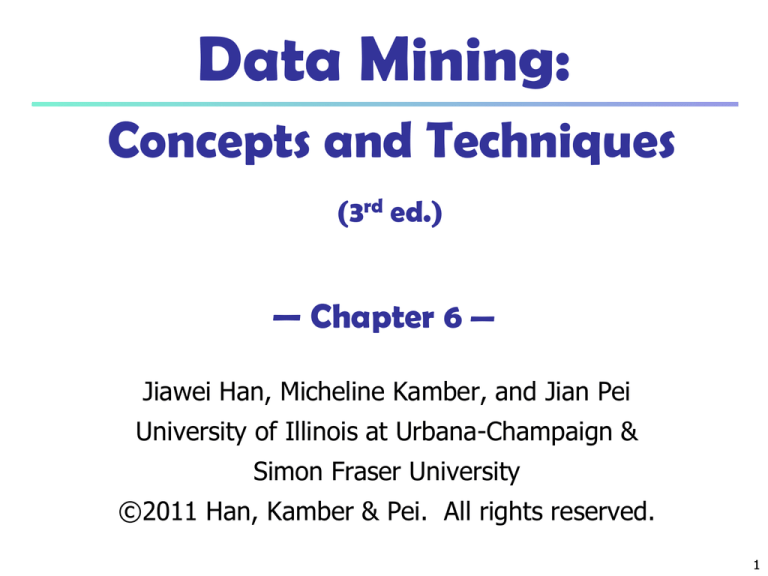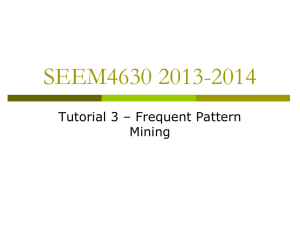
Data Mining:
Concepts and Techniques
(3rd ed.)
— Chapter 6 —
Jiawei Han, Micheline Kamber, and Jian Pei
University of Illinois at Urbana-Champaign &
Simon Fraser University
©2011 Han, Kamber & Pei. All rights reserved.
1
What Is Frequent Pattern Analysis?
Frequent pattern: a pattern (a set of items, subsequences, substructures,
etc.) that occurs frequently in a data set
First proposed by Agrawal, Imielinski, and Swami [AIS93] in the context
of frequent itemsets and association rule mining
Motivation: Finding inherent regularities in data
What products were often purchased together?— Beer and diapers?!
What are the subsequent purchases after buying a PC?
What kinds of DNA are sensitive to this new drug?
Can we automatically classify web documents?
Applications
Basket data analysis, cross-marketing, catalog design, sale campaign
analysis, Web log (click stream) analysis, and DNA sequence analysis.
2
Basic Concepts: Frequent Patterns
Tid
Items bought
10
Beer, Nuts, Diaper
20
Beer, Coffee, Diaper
30
Beer, Diaper, Eggs
40
Nuts, Eggs, Milk
50
Nuts, Coffee, Diaper, Eggs, Milk
Customer
buys both
Customer
buys diaper
Customer
buys beer
itemset: A set of one or more
items
k-itemset X = {x1, …, xk}
(absolute) support, or, support
count of X: Frequency or
occurrence of an itemset X
(relative) support, s, is the
fraction of transactions that
contains X (i.e., the probability
that a transaction contains X)
An itemset X is frequent if X’s
support is no less than a minsup
threshold
3
Basic Concepts: Association Rules
Tid
Items bought
10
Beer, Nuts, Diaper
20
Beer, Coffee, Diaper
30
Beer, Diaper, Eggs
40
50
Nuts, Eggs, Milk
Nuts, Coffee, Diaper, Eggs, Milk
Customer
buys both
Customer
buys beer
Customer
buys
diaper
Find all the rules X Y with
minimum support and confidence
support, s, probability that a
transaction contains X Y
confidence, c, conditional
probability that a transaction
having X also contains Y
Let minsup = 50%, minconf = 50%
Freq. Pat.: Beer:3, Nuts:3, Diaper:4, Eggs:3,
{Beer, Diaper}:3
Association rules: (many more!)
Beer Diaper (60%, 100%)
Diaper Beer (60%, 75%)
4
Closed Patterns and Max-Patterns
A long pattern contains a combinatorial number of subpatterns, e.g., {a1, …, a100} contains (1001) + (1002) + … +
(110000) = 2100 – 1 = 1.27*1030 sub-patterns!
Solution: Mine closed patterns and max-patterns instead
An itemset X is closed if X is frequent and there exists no
super-pattern Y כX, with the same support as X
(proposed by Pasquier, et al. @ ICDT’99)
An itemset X is a max-pattern if X is frequent and there
exists no frequent super-pattern Y כX (proposed by
Bayardo @ SIGMOD’98)
Closed pattern is a lossless compression of freq. patterns
Reducing the # of patterns and rules
5
Closed Patterns and Max-Patterns
Exercise. DB = {<a1, …, a100>, < a1, …, a50>}
What is the set of closed itemset?
<a1, …, a100>: 1
< a1, …, a50>: 2
What is the set of max-pattern?
Min_sup = 1.
<a1, …, a100>: 1
What is the set of all patterns?
!!
6
Computational Complexity of Frequent Itemset
Mining
How many itemsets are potentially to be generated in the worst case?
The number of frequent itemsets to be generated is senstive to the
minsup threshold
When minsup is low, there exist potentially an exponential number of
frequent itemsets
The worst case: MN where M: # distinct items, and N: max length of
transactions
The worst case complexty vs. the expected probability
Ex. Suppose Walmart has 104 kinds of products
The chance to pick up one product 10-4
The chance to pick up a particular set of 10 products: ~10-40
What is the chance this particular set of 10 products to be frequent
103 times in 109 transactions?
7
Scalable Frequent Itemset Mining Methods
Apriori: A Candidate Generation-and-Test
Approach
FPGrowth: A Frequent Pattern-Growth Approach
ECLAT: Frequent Pattern Mining with Vertical
Data Format
8
Pattern-Growth Approach: Mining Frequent
Patterns Without Candidate Generation
Bottlenecks of the Apriori approach
Breadth-first (i.e., level-wise) search
Candidate generation and test
Often generates a huge number of candidates
The FPGrowth Approach (J. Han, J. Pei, and Y. Yin, SIGMOD’ 00)
Depth-first search
Avoid explicit candidate generation
Major philosophy: Grow long patterns from short ones using local
frequent items only
“abc” is a frequent pattern
Get all transactions having “abc”, i.e., project DB on abc: DB|abc
“d” is a local frequent item in DB|abc abcd is a frequent pattern
9
Construct FP-tree from a Transaction Database
TID
100
200
300
400
500
Items bought
(ordered) frequent items
{f, a, c, d, g, i, m, p}
{f, c, a, m, p}
{a, b, c, f, l, m, o}
{f, c, a, b, m}
min_support = 3
{b, f, h, j, o, w}
{f, b}
{b, c, k, s, p}
{c, b, p}
{a, f, c, e, l, p, m, n}
{f, c, a, m, p}
{}
Header Table
1. Scan DB once, find
f:4
c:1
Item frequency head
frequent 1-itemset (single
f
4
item pattern)
c
4
c:3 b:1 b:1
2. Sort frequent items in
a
3
b
3
frequency descending
a:3
p:1
m
3
order, f-list
p
3
m:2 b:1
3. Scan DB again, construct
FP-tree
p:2 m:1
F-list = f-c-a-b-m-p
10
Partition Patterns and Databases
Frequent patterns can be partitioned into subsets
according to f-list
F-list = f-c-a-b-m-p
Patterns containing p
Patterns having m but no p
…
Patterns having c but no a nor b, m, p
Pattern f
Completeness and non-redundency
11
Find Patterns Having P From P-conditional Database
Starting at the frequent item header table in the FP-tree
Traverse the FP-tree by following the link of each frequent item p
Accumulate all of transformed prefix paths of item p to form p’s
conditional pattern base
{}
Header Table
Item frequency head
f
4
c
4
a
3
b
3
m
3
p
3
f:4
c:3
c:1
b:1
a:3
Conditional pattern bases
item
cond. pattern base
b:1
c
f:3
p:1
a
fc:3
b
fca:1, f:1, c:1
m:2
b:1
m
fca:2, fcab:1
p:2
m:1
p
fcam:2, cb:1
12
From Conditional Pattern-bases to Conditional FP-trees
For each pattern-base
Accumulate the count for each item in the base
Construct the FP-tree for the frequent items of the
pattern base
Header Table
Item frequency head
f
4
c
4
a
3
b
3
m
3
p
3
{}
f:4
c:3
c:1
b:1
a:3
b:1
p:1
m:2
b:1
p:2
m:1
m-conditional pattern base:
fca:2, fcab:1
All frequent
patterns relate to m
{}
m,
f:3 fm, cm, am,
fcm, fam, cam,
c:3
fcam
a:3
m-conditional FP-tree
13
Recursion: Mining Each Conditional FP-tree
{}
{}
Cond. pattern base of “am”: (fc:3)
c:3
f:3
c:3
a:3
f:3
am-conditional FP-tree
Cond. pattern base of “cm”: (f:3)
{}
f:3
m-conditional FP-tree
cm-conditional FP-tree
{}
Cond. pattern base of “cam”: (f:3)
f:3
cam-conditional FP-tree
14
A Special Case: Single Prefix Path in FP-tree
{}
a1:n1
a2:n2
Suppose a (conditional) FP-tree T has a shared
single prefix-path P
Mining can be decomposed into two parts
Reduction of the single prefix path into one node
Concatenation of the mining results of the two
parts
a3:n3
b1:m1
C2:k2
r1
{}
C1:k1
C3:k3
r1
=
a1:n1
a2:n2
a3:n3
+
b1:m1
C2:k2
C1:k1
C3:k3
15
Benefits of the FP-tree Structure
Completeness
Preserve complete information for frequent pattern
mining
Never break a long pattern of any transaction
Compactness
Reduce irrelevant info—infrequent items are gone
Items in frequency descending order: the more
frequently occurring, the more likely to be shared
Never be larger than the original database (not count
node-links and the count field)
16
The Frequent Pattern Growth Mining Method
Idea: Frequent pattern growth
Recursively grow frequent patterns by pattern and
database partition
Method
For each frequent item, construct its conditional
pattern-base, and then its conditional FP-tree
Repeat the process on each newly created conditional
FP-tree
Until the resulting FP-tree is empty, or it contains only
one path—single path will generate all the
combinations of its sub-paths, each of which is a
frequent pattern
17
Performance of FPGrowth in Large Datasets
100
140
120
D1 Apriori runtime
80
Runtime (sec.)
70
Run time(sec.)
D2 FP-growth
D1 FP-grow th runtime
90
60
Data set T25I20D10K
50
40
30
20
D2 TreeProjection
100
80
Data set T25I20D100K
60
40
20
10
0
0
0
0.5
1
1.5
2
Support threshold(%)
2.5
FP-Growth vs. Apriori
3
0
0.5
1
1.5
2
Support threshold (%)
FP-Growth vs. Tree-Projection
18
Advantages of the Pattern Growth Approach
Divide-and-conquer:
Lead to focused search of smaller databases
Other factors
No candidate generation, no candidate test
Compressed database: FP-tree structure
No repeated scan of entire database
Decompose both the mining task and DB according to the
frequent patterns obtained so far
Basic ops: counting local freq items and building sub FP-tree, no
pattern search and matching
A good open-source implementation and refinement of FPGrowth
FPGrowth+ (Grahne and J. Zhu, FIMI'03)
19
Extension of Pattern Growth Mining Methodology
Mining closed frequent itemsets and max-patterns
CLOSET (DMKD’00), FPclose, and FPMax (Grahne & Zhu, Fimi’03)
Mining sequential patterns
PrefixSpan (ICDE’01), CloSpan (SDM’03), BIDE (ICDE’04)
Mining graph patterns
gSpan (ICDM’02), CloseGraph (KDD’03)
Constraint-based mining of frequent patterns
Convertible constraints (ICDE’01), gPrune (PAKDD’03)
Computing iceberg data cubes with complex measures
H-tree, H-cubing, and Star-cubing (SIGMOD’01, VLDB’03)
Pattern-growth-based Clustering
MaPle (Pei, et al., ICDM’03)
Pattern-Growth-Based Classification
Mining frequent and discriminative patterns (Cheng, et al, ICDE’07)
20
ECLAT: Mining by Exploring Vertical Data
Format
Vertical format: t(AB) = {T11, T25, …}
tid-list: list of trans.-ids containing an itemset
Deriving frequent patterns based on vertical intersections
t(X) = t(Y): X and Y always happen together
t(X) t(Y): transaction having X always has Y
Using diffset to accelerate mining
Only keep track of differences of tids
t(X) = {T1, T2, T3}, t(XY) = {T1, T3}
Diffset (XY, X) = {T2}
Eclat (Zaki et al. @KDD’97)
Mining Closed patterns using vertical format: CHARM (Zaki &
Hsiao@SDM’02)
21
Summary
Basic concepts: association rules, supportconfident framework, closed and max-patterns
Scalable frequent pattern mining methods
Apriori (Candidate generation & test)
Projection-based (FPgrowth, CLOSET+, ...)
Vertical format approach (ECLAT, CHARM, ...)
Which patterns are interesting?
Pattern evaluation methods
22
Ref: Basic Concepts of Frequent Pattern Mining
(Association Rules) R. Agrawal, T. Imielinski, and A. Swami. Mining
association rules between sets of items in large databases. SIGMOD'93
(Max-pattern) R. J. Bayardo. Efficiently mining long patterns from
databases. SIGMOD'98
(Closed-pattern) N. Pasquier, Y. Bastide, R. Taouil, and L. Lakhal.
Discovering frequent closed itemsets for association rules. ICDT'99
(Sequential pattern) R. Agrawal and R. Srikant. Mining sequential patterns.
ICDE'95
23












